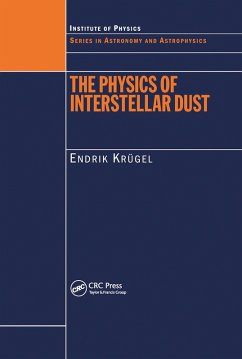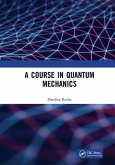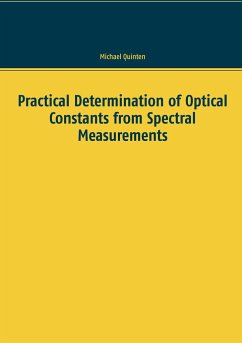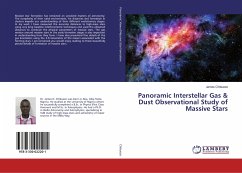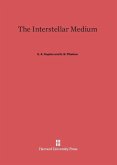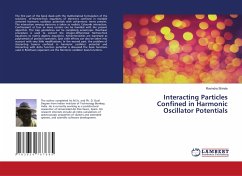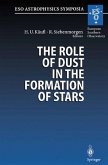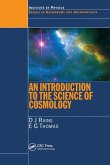Endrik Krugel
The Physics of Interstellar Dust
Endrik Krugel
The Physics of Interstellar Dust
- Broschiertes Buch
- Merkliste
- Auf die Merkliste
- Bewerten Bewerten
- Teilen
- Produkt teilen
- Produkterinnerung
- Produkterinnerung
Interstellar dust grains catalyse chemical reactions, absorb, scatter, polarise and re-radiate starlight and constitute the building blocks for the formation of planets. Understanding this interstellar component is therefore of primary importance in many areas of astronomy & astrophysics. For example, observers need to understand how dust effects light passing through molecular clouds. Astrophysicists wish to comprehend how dust enables the collapse of clouds or how it determines the spectral behaviour of protostars, star forming regions or whole galaxies. This book gives a thorough…mehr
Andere Kunden interessierten sich auch für
![A Course in Quantum Mechanics A Course in Quantum Mechanics]() Nandita RudraA Course in Quantum Mechanics46,99 €
Nandita RudraA Course in Quantum Mechanics46,99 €![Practical Determination of Optical Constants from Spectral Measurements Practical Determination of Optical Constants from Spectral Measurements]() Michael QuintenPractical Determination of Optical Constants from Spectral Measurements18,00 €
Michael QuintenPractical Determination of Optical Constants from Spectral Measurements18,00 €![Panoramic Interstellar Gas & Dust Observational Study of Massive Stars Panoramic Interstellar Gas & Dust Observational Study of Massive Stars]() James ChibuezePanoramic Interstellar Gas & Dust Observational Study of Massive Stars43,99 €
James ChibuezePanoramic Interstellar Gas & Dust Observational Study of Massive Stars43,99 €![The Interstellar Medium The Interstellar Medium]() S. A. KaplanThe Interstellar Medium60,00 €
S. A. KaplanThe Interstellar Medium60,00 €![Interacting Particles Confined in Harmonic Oscillator Potentials Interacting Particles Confined in Harmonic Oscillator Potentials]() Ravindra ShindeInteracting Particles Confined in Harmonic Oscillator Potentials36,99 €
Ravindra ShindeInteracting Particles Confined in Harmonic Oscillator Potentials36,99 €![The Role of Dust in the Formation of Stars The Role of Dust in the Formation of Stars]() The Role of Dust in the Formation of Stars39,99 €
The Role of Dust in the Formation of Stars39,99 €![An Introduction to the Science of Cosmology An Introduction to the Science of Cosmology]() Derek RaineAn Introduction to the Science of Cosmology98,99 €
Derek RaineAn Introduction to the Science of Cosmology98,99 €-
-
-
Interstellar dust grains catalyse chemical reactions, absorb, scatter, polarise and re-radiate starlight and constitute the building blocks for the formation of planets. Understanding this interstellar component is therefore of primary importance in many areas of astronomy & astrophysics. For example, observers need to understand how dust effects light passing through molecular clouds. Astrophysicists wish to comprehend how dust enables the collapse of clouds or how it determines the spectral behaviour of protostars, star forming regions or whole galaxies. This book gives a thorough theoretical description of the fundamental physics of interstellar dust: its composition, morphology, size distribution, dynamics, optical and thermal properties, alignment, polarisation, scattering, radiation and spectral features.
This encyclopedic book provides the basic physics towards understanding the solid matter in interstellar space. It includes all the necessary physics, including solid state physics, radiative transport, optical properties, thermodynamics, statistical mechanics and quantum mechanics. It then uses all of this basic physics in the specific case of dust grains in the interstellar medium.
Interstellar dust clouds catalyze simple chemical reactions, absorbs, scatters, polarizes and re-radiates starlight and forms the building blocks for planet and stellar formation. Understanding this interstellar medium is then of primary importance in many areas of astronomy & astrophysics. For example observers need to understand how it effects light passing through dust and molecular clouds, astrophysicists need to comprehend the formation and structure of dust clouds and how it collapses to form stars and planets.
Written in an accessible and descriptive manner, this will be essential supplementary reading for advanced undergraduate and graduate students taking courses on the interstellar medium and active researchers in need of a single sourceof well illustrated and detailed information.
This encyclopedic book provides the basic physics towards understanding the solid matter in interstellar space. It includes all the necessary physics, including solid state physics, radiative transport, optical properties, thermodynamics, statistical mechanics and quantum mechanics. It then uses all of this basic physics in the specific case of dust grains in the interstellar medium.
Interstellar dust clouds catalyze simple chemical reactions, absorbs, scatters, polarizes and re-radiates starlight and forms the building blocks for planet and stellar formation. Understanding this interstellar medium is then of primary importance in many areas of astronomy & astrophysics. For example observers need to understand how it effects light passing through dust and molecular clouds, astrophysicists need to comprehend the formation and structure of dust clouds and how it collapses to form stars and planets.
Written in an accessible and descriptive manner, this will be essential supplementary reading for advanced undergraduate and graduate students taking courses on the interstellar medium and active researchers in need of a single sourceof well illustrated and detailed information.
Produktdetails
- Produktdetails
- Series in Astronomy and Astrophysics
- Verlag: CRC Press / Taylor & Francis
- Seitenzahl: 584
- Erscheinungstermin: 7. Januar 2019
- Englisch
- Abmessung: 234mm x 156mm x 31mm
- Gewicht: 453g
- ISBN-13: 9780367454654
- ISBN-10: 0367454653
- Artikelnr.: 71941020
- Herstellerkennzeichnung
- Libri GmbH
- Europaallee 1
- 36244 Bad Hersfeld
- gpsr@libri.de
- Series in Astronomy and Astrophysics
- Verlag: CRC Press / Taylor & Francis
- Seitenzahl: 584
- Erscheinungstermin: 7. Januar 2019
- Englisch
- Abmessung: 234mm x 156mm x 31mm
- Gewicht: 453g
- ISBN-13: 9780367454654
- ISBN-10: 0367454653
- Artikelnr.: 71941020
- Herstellerkennzeichnung
- Libri GmbH
- Europaallee 1
- 36244 Bad Hersfeld
- gpsr@libri.de
Endrik Krügel Max-Planck-Institut für Radioastronomie, Bonn, Germany
Preface, 1 The dielectric permeability, 1.1 Maxwell's equations, 1.1.1 Electric field and magnetic induction, 1.1.2 Electric polarization of the medium, 1.1.3 The dependence of the dielectric permeability on direction and frequency, 1.1.4 The physical meaning of the electric susceptibility x, 1.1.5 Magnetic polarization of the medium, 1.1.6 The magnetic susceptibility, 1.1.7 Dielectrics and metals, 1.1.8 Free charges and polarization charges, 1.1.9 The field equations, 1.2 Waves in a dielectric medium, 1.2.1 The wave equation, 1.2.2 The wave number, 1.2.3 The optical constant or refractive index, 1.2.4 Energy dissipation of a grain in a variable field, 1.3 The harmonic oscillator, 1.3.1 The Lorentz model, 1.3.2 Free oscillations, 1.3.3 The general solution to the oscillator equation, 1.3.4 Dissipation of energy in a forced oscillation, 1.3.5 Dissipation of energy in a free oscillation, 1.3.6 The plasma frequency, 1.3.7 Dispersion relation of the dielectric permeability, 1.4 The harmonic oscillator and light, 1.4.1 Attenuation and refraction of light, 1.4.2 Retarded potentials of a moving charge, 1.4.3 Emission of an harmonic oscillator, 1.4.4 Radiation of higher order, 1.4.5 Radiation damping, 1.4.6 The cross section of an harmonic oscillator, 1.4.7 The oscillator strength, 1.4.8 The natural line width, 1.5 Waves in a conducting medium, 1.5.1 The dielectric permeability of a conductor, 1.5.2 Conductivity and the Drude profile, 1.5.3 Electromagnetic waves in a plasma with a magnetic field, 1.5.4 Group velocity of electromagnetic waves in a plasma, 1.6 Polarization through orientation, 1.6.1 Polarization in a constant field, 1.6.2 Polarization in a time-variable field, 1.6.3 Relaxation after switching off the field, 1.6.4 The dielectric permeability in Debye relaxation, 2 How to evaluate grain cross sections, 2.1 Defining cross sections, 2.1.1 Cross section for scattering, absorption and extinction, 2.1.2 Cross section for radiation pressure, 2.1.3 Efficiencies, mass and volume coefficients, 2.2 The optical theorem, 2.2.1 The intensity of forward scattered light, 2.2.2 The refractive index of a dusty medium, 2.3 Mie theory for a sphere, 2.3.1 The generating function, 2.3.2 Separation of variables, 2.3.3 Series expansion of waves, 2.3.4 Expansion coefficients, 2.3.5 Scattered and absorbed power, 2.3.6 Absorption and scattering efficiencies, 2.4 Polarization and scattering, 2.4.1 The amplitude scattering matrix, 2.4.2 Angle-dependence of scattering, 2.4.3 The polarization ellipse, 2.4.4 Stokes parameters, 2.4.5 Stokes parameters of scattered light for a sphere, 2.5 The Kramers-Kronig relations, 2.5.1 Mathematical formulation of the relations, 2.5.2 The electric susceptibility and causality, 2.5.3 The Kramers-Kronig relation for the dielectric permeability, 2.5.4 Extension to metals, 2.5.5 Dispersion of the magnetic susceptibility, 2.5.6 Three corollaries of the KK relation, 2.6 Composite grains, 2.6.1 Effective medium theories, 2.6.2 Garnett's mixing rule, 2.6.3 The mixing rule of Bruggeman, 2.6.4 Composition of grains in protostellar cores, 2.6.5 How size, ice and porosity change the absorption coefficient, 3 Very small and very big particles, 3.1 Tiny spheres, 3.1.1 When is a particle in the Rayleigh limit?, 3.1.2 Efficiencies of small spheres from Mie theory, 3.1.3 A dielectric sphere in a constant electric field, 3.1.4 Scattering and absorption in the electrostatic approximation, 3.1.5 Polarization and angle-dependent scattering, 3.1.6 Small-size effects beyond Mie theory, 3.2 A small metallic sphere in a magnetic field, 3.2.1 Slowly varying field, 3.2.2 The magnetic polarizability, 3.2.3 The penetration depth, 3.2.4 Limiting values of the magnetic polarizability, 3.3 Tiny ellipsoids, 3.3.1 Elliptical coordinates, 3.3.2 An ellipsoid in a constant electric field, 3.3.3 Cross section and shape factor, 3.3.4 Randomly oriented ellipsoids, 3.3.5 Pancakes and cigars, 3.3.6 Rotation about the axis of greatest moment of inertia, 3.4 The fields inside a dielectric particle, 3.4.1 Internal field and depolarization field, 3.4.2 Depolarization field and the distribution of surface charges, 3.4.3 The local field at an atom, 3.4.4 The Clausius-Mossotti relation, 3.5 Very large particles, 3.5.1 Babinet's theorem, 3.5.2 Reflection and transmission at a plane surface, 3.5.3 Huygens' principle, 3.5.4 Fresnel zones and a check on Huygens' principle, 3.5.5 The reciprocity theorem, 3.5.6 Diffraction by a circular hole or a sphere, 3.5.7 Diffraction behind a half-plane, 3.5.8 Particles of small refractive index, 3.5.9 X-ray scattering, 4 Case studies of Mie calculus, 4.1 Efficiencies of bare spheres, 4.1.1 Pure scattering, 4.1.2 A weak absorber, 4.1.3 A strong absorber, 4.1.4 A metal sphere, 4.1.5 Efficiency versus cross section and volume coefficient, 4.1.6 The atmosphere of the Earth, 4.2 Scattering by bare spheres, 4.2.1 The scattering diagram, 4.2.2 The polarization of scattered light, 4.2.3 The intensity of scattered light in a reflection nebula, 4.3 Coated spheres, 4.4 Surface modes in small grains, 4.5 Efficiencies of idealized dielectrics and metals, 4.5.1 Dielectric sphere consisting of identical harmonic oscillators, 4.5.2 Dielectric sphere with Debye relaxation, 4.5.3 Magnetic and electric dipole absorption of small metal spheres, 4.5.4 Efficiencies for Drude profiles, 4.5.5 Elongated metallic particles, 5 Particle statistics, 5.1 Boltzmann statistics, 5.1.1 The probability of an arbitrary energy distribution, 5.1.2 The distribution of maximum probability, 5.1.3 Partition function and population of energy cells, 5.1.4 The mean energy of harmonic oscillators, 5.1.5 The Maxwellian velocity distribution, 5.2 Quantum statistics, 5.2.1 The unit cell h3 of the phase space, 5.2.2 Bosons and fermions, 5.2.3 Bose statistics, 5.2.4 Bose statistics for photons, 5.2.5 Fermi statistics, 5.2.6 Ionization equilibrium and the Saha equation, 5.3 Thermodynamics, 5.3.1 The ergodic hypothesis, 5.3.2 Definition of entropy and temperature, 5.3.3 The canonical distribution, 5.3.4 Thermodynamic relations for a gas, 5.3.5 Equilibrium conditions of the state functions, 5.3.6 Specific heat of a gas, 5.3.7 The work done by magnetization, 5.3.8 Susceptibility and specific heat of magnetic substances, 5.4 Blackbody radiation, 5.4.1 The Planck function, 5.4.2 Low- and high-frequency limit, 5.4.3 Wien's displacement law and the Stefan-Boltzmann law, 5.4.4 The Planck function and harmonic oscillators, 6 The radiative transition probability, 6.1 A charged particle in an electromagnetic field, 6.1.1 The classical Hamiltonian, 6.1.2 The Hamiltonian of an electron in an electromagnetic field, 6.1.3 The Hamilton operator in quantum mechanics, 6.1.4 The dipole moment in quantum mechanics, 6.1.5 The quantized harmonic oscillator, 6.2 Small perturbations, 6.2.1 The perturbation energy, 6.2.2 The transition probability, 6.2.3 Transition probability for a time-variable perturbation, 6.3 The Einstein coefficients A and B, 6.3.1 Induced and spontaneous transitions, 6.3.2 Selection rules and polarization rules, 6.3.3 Quantization of the electromagnetic field, 6.3.4 Quantum-mechanical derivation of A and B, 6.4 Potential wells and tunneling, 6.4.1 Wavefunction of a particle in a constant potential, 6.4.2 Potential walls and Fermi energy, 6.4.3 Rectangular potential barriers, 6.4.4 The double potential well, 7 Structure and composition of dust, 7.1 Crystal structure, 7.1.1 Translational symmetry, 7.1.2 Lattice types, 7.1.3 The reciprocal lattice, 7.2 Binding in crystals, 7.2.1 Covalent bonding, 7.2.2 Ionic bonding, 7.2.3 Metals, 7.2.4 van der Waals forces and hydrogen bridges, 7.3 Reddening by interstellar grains, 7.3.1 Stellar photometry, 7.3.2 The interstellar extinction curve, 7.3.3 Two-color diagrams, 7.3.4 Spectral indices, 7.3.5 The mass absorption coefficient, 7.4 Carbonaceous grains and silicate grains, 7.4.1 Origin of the two major dust constituents, 7.4.2 The bonding in carbon, 7.4.3 Carbon compounds, 7.4.4 Silicates, 7.4.5 A standard set of optical constants, 7.5 Grain sizes and optical constants, 7.5.1 The size distribution, 7.5.2 Collisional fragmentation, 8 Dust radiation, 8.1 Kirchhoff's law, 8.1.1 The emissivity of dust, 8.1.2 Thermal emission of grains, 8.1.3 Absorption and emission in thermal equilibrium, 8.1.4 Equipartition of energy, 8.2 The temperature of big grains, 8.2.1 The energy equation, 8.2.2 Approximate absorption efficiency at infrared wavelengths, 8.2.3 Temperature estimates, 8.2.4 Relation between grain size and grain temperature, 8.2.5 Temperature of dust grains near a star, 8.2.6 Dust temperatures from observations, 8.3 The emission spectrum of big grains, 8.3.1 Constant temperature and low optical depth, 8.3.2 Constant temperature and arbitrary optical depth, 8.4 Calorific properties of solids, 8.4.1 Normal coordinates, 8.4.2 Internal energy of a grain, 8.4.3 Standing waves in a crystal, 8.4.4 The density of vibrational modes in a crystal, 8.4.5 Specific heat, 8.4.6 Two-dimensional lattices, 8.5 Temperature fluctuations of very small grains, 8.5.1 The probability density, 8.5.2 The transition matrix, 8.5.3 Practical considerations, 8.5.4 The stochastic time evolution of grain temperature, 8.6 The emission spectrum of very small grains, 8.6.1 Small and moderate fluctuations, 8.6.2 Strong fluctuations, 8.6.3 Temperature fluctuations and flux ratios, 9 Dust and its environment, 9.1 Grain surfaces, 9.1.1 Gas accretion on grains, 9.1.2 Physical adsorption and chemisorption, 9.1.3 The sticking probability, 9.1.4 Thermal hopping, evaporation and reactions with activation barrier, 9.1.5 Tunneling between surface sites, 9.1.6 Scanning time, 9.2 Grain charge, 9.2.1 Charge equilibrium in the absence of a UV radiation field, 9.2.2 The photoelectric effect, 9.3 Grain motion, 9.3.1 Random walk, 9.3.2 The drag on a grain subjected to a constant outer force, 9.3.3 Brownian motion of a grain, 9.3.4 The disorder time, 9.3.5 Laminar and turbulent friction, 9.3.6 A falling rain drop, 9.3.7 The Poynting-Robertson effect, 9.4 Grain destruction, 9.4.1 Mass balance in the Milky Way, 9.4.2 Destruction processes, 9.5 Grain formation, 9.5.1 Evaporation temperature of dust, 9.5.2 Vapor pressure of small grains, 9.5.3 Critical saturation, 9.5.4 Equations for time-dependent homogeneous nucleation, 9.5.5 Equilibrium distribution and steady-state nucleation, 9.5.6 Solutions to time-dependent homogeneous nucleation, 9.5.7 Similarity relations, 10 Polarization, 10.1 Efficiency of infinite cylinders, 10.1.1 Normal incidence and picket fence alignment, 10.1.2 Oblique incidence, 10.1.3 Rotating cylinders, 10.1.4 Absorption efficiency as a function of wavelength, 10.2 Linear polarization through extinction, 10.2.1 Effective optical depth and degree of polarization p(.), 10.2.2 The Serkowski curve, 10.2.3 Polarization p(.) of infinite cylinders, 10.2.4 Polarization p(.) of ellipsoids in the Rayleigh limit, 10.2.5 Polarization p(.) of spheroids at optical wavelengths, 10.2.6 Polarization and reddening, 10.3 Polarized emission, 10.3.1 The wavelength dependence of polarized emission for cylinders, 10.3.2 Infrared emission of spheroids, 10.3.3 Polarized emission versus polarized extinction, 10.4 Circular polarization, 10.4.1 The phase shift induced by grains, 10.4.2 The wavelength dependence of circular polarization, 11 Grain alignment, 11.1 Grain rotation, 11.1.1 Euler's equations for a rotating body, 11.1.2 Symmetric tops, 11.1.3 Atomic magnet in a magnetic field, 11.1.4 Rotational Brownian motion, 11.1.5 Suprathermal rotation, 11.2 Magnetic dissipation, 11.2.1 Diamagnetism, 11.2.2 Paramagnetism, 11.2.3 Ferromagnetism, 11.2.4 The magnetization of iron above and below the Curie point, 11.2.5 Paramagnetic dissipation: spin-spin and spin-lattice relaxation, 11.2.6 The magnetic susceptibility for spin-lattice relaxation, 11.2.7 The magnetic susceptibility in spin-spin relaxation, 11.3 Magnetic alignment, 11.3.1 A rotating dipole in a magnetic field, 11.3.2 Timescales for alignment and disorder, 11.3.3 Super-paramagnetism, 11.3.4 Ferromagnetic relaxation, 11.3.5 Alignment of angular momentum with the axis of greatest inertia, 11.3.6 Mechanical and magnetic damping, 11.4 Non-magnetic alignment, 11.4.1 Gas streaming, 11.4.2 Anisotropic illumination, 12 PAHs and spectral features of dust, 12.1 Thermodynamics of PAHs, 12.1.1 What are PAHs?, 12.1.2 Microcanonic emission of PAHs, 12.1.3 The vibrational modes of anthracene, 12.1.4 Microcanonic versus thermal level population, 12.1.5 Does an ensemble of PAHs have a temperature?, 12.2 PAH emission, 12.2.1 Photoexcitation of PAHs, 12.2.2 Cutoff wavelength for electronic excitation, 12.2.3 Photo-destruction and ionization, 12.2.4 Cross sections and line profiles of PAHs, 12.3 Big grains and ices, 12.3.1 The silicate features and the band at 3.4 µm, 12.3.2 Icy grain mantles, 12.4 An overall dust model, 12.4.1 The three dust components, 12.4.2 Extinction coefficient in the diffuse medium, 12.4.3 Extinction coefficient in protostellar cores, 13 Radiative transport, 13.1 Basic transfer relations, 13.1.1 Radiative intensity and flux, 13.1.2 The transfer equation and its formal solution, 13.1.3 The brightness temperature, 13.1.4 The main-beam-brightness temperature of a telescope, 13.2 Spherical clouds, 13.2.1 Moment equations for spheres, 13.2.2 Frequency averages, 13.2.3 Differential equations for the intensity, 13.2.4 Integral equations for the intensity, 13.2.5 Practical hints, 13.3 Passive disks, 13.3.1 Radiative transfer in a plane parallel layer, 13.3.2 The grazing angle in an inflated disk, 13.4 Galactic nuclei, 13.4.1 Hot spots in a spherical stellar cluster, 13.4.2 Low and high luminosity stars, 13.5 Line radiation, 13.5.1 Absorption coefficient and absorption profile, 13.5.2 The excitation temperature of a line, 13.5.3 Radiative transfer in lines, 14 Diffuse matter in the Milky Way, 14.1 Overview of the Milky Way, 14.1.1 Global parameters, 14.1.2 The relevance of dust, 14.2 Molecular clouds, 14.2.1 The CO molecule, 14.2.2 Population of levels in CO, 14.2.3 Molecular hydrogen, 14.2.4 Formation of molecular hydrogen on dust surfaces, 14.3 Clouds of atomic hydrogen, 14.3.1 General properties of the diffuse gas, 14.3.2 The 21 cm line of atomic hydrogen, 14.3.3 How the hyperfine levels of atomic hydrogen are excited, 14.3.4 Gas density and temperature from the 21 cm line, 14.3.5 The deuterium hyperfine line, 14.3.6 Electron density and magnetic field in the diffuse gas, 14.4 HII regions, 14.4.1 Ionization and recombination, 14.4.2 Dust-free HII regions, 14.4.3 Dusty HII regions, 14.4.4 Bremsstrahlung, 14.4.5 Recombination lines, 14.5 Mass estimates of interstellar clouds, 14.5.1 From optically thin CO lines, 14.5.2 From the CO luminosity, 14.5.3 From dust emission, 15 Stars and their formatio, 15.1 Stars on and beyond the main sequence, 15.1.1 Nuclear burning and the creation of elements, 15.1.2 The binding energy of an atomic nucleus, 15.1.3 Hydrogen burning, 15.1.4 The 3a process, 15.1.5 Lifetime and luminosity of stars, 15.1.6 The initial mass function, 15.2 Clouds near gravitational equilibrium, 15.2.1 Virialized clouds, 15.2.2 Isothermal cloud in pressure equilibrium, 15.2.3 Structure and stability of Ebert-Bonnor spheres, 15.2.4 Free-fall of a gas ball, 15.2.5 The critical mass for gravitational instability, 15.2.6 Implications of the Jeans criterion, 15.2.7 Magnetic fields and ambipolar diffusion, 15.3 Gravitational collapse, 15.3.1 The presolar nebula, 15.3.2 Hydrodynamic collapse simulations, 15.3.3 Similarity solutions of collapse, 15.4 Disks, 15.4.1 Viscous laminar flows, 15.4.2 Dynamical equations of the thin accretion disk, 15.4.3 The Kepler disk, 15.4.4 Why a star accretes from a disk, 15.4.5 The stationary accretion disk, 15.4.6 The a-disk, 15.4.7 Disk heating by viscosity, 16 Emission from young star, 16.1 The earliest stages of star formation, 16.1.1 Globules, 16.1.2 Isothermal gravitationally-bound clumps, 16.2 The collapse phase, 16.2.1 The density structure of a protostar, 16.2.2 Dust emission from a solar-type protostar, 16.2.3 Kinematics of protostellar collapse, 16.3 Accretion disks, 16.3.1 A flat blackbody disk, 16.3.2 A flat non-blackbody disk, 16.3.3 Radiative transfer in an inflated disk, 16.4 Reflection nebulae, 16.5 Cold and warm dust in galaxies, 16.6 Starburst nuclei, 16.6.1 Repetitive bursts of star formation, 16.6.2 Dust emission from starburst nuclei, Appendix A Mathematical formulae, Appendix B List of symbols, References, Index
Preface, 1 The dielectric permeability, 1.1 Maxwell's equations, 1.1.1 Electric field and magnetic induction, 1.1.2 Electric polarization of the medium, 1.1.3 The dependence of the dielectric permeability on direction and frequency, 1.1.4 The physical meaning of the electric susceptibility x, 1.1.5 Magnetic polarization of the medium, 1.1.6 The magnetic susceptibility, 1.1.7 Dielectrics and metals, 1.1.8 Free charges and polarization charges, 1.1.9 The field equations, 1.2 Waves in a dielectric medium, 1.2.1 The wave equation, 1.2.2 The wave number, 1.2.3 The optical constant or refractive index, 1.2.4 Energy dissipation of a grain in a variable field, 1.3 The harmonic oscillator, 1.3.1 The Lorentz model, 1.3.2 Free oscillations, 1.3.3 The general solution to the oscillator equation, 1.3.4 Dissipation of energy in a forced oscillation, 1.3.5 Dissipation of energy in a free oscillation, 1.3.6 The plasma frequency, 1.3.7 Dispersion relation of the dielectric permeability, 1.4 The harmonic oscillator and light, 1.4.1 Attenuation and refraction of light, 1.4.2 Retarded potentials of a moving charge, 1.4.3 Emission of an harmonic oscillator, 1.4.4 Radiation of higher order, 1.4.5 Radiation damping, 1.4.6 The cross section of an harmonic oscillator, 1.4.7 The oscillator strength, 1.4.8 The natural line width, 1.5 Waves in a conducting medium, 1.5.1 The dielectric permeability of a conductor, 1.5.2 Conductivity and the Drude profile, 1.5.3 Electromagnetic waves in a plasma with a magnetic field, 1.5.4 Group velocity of electromagnetic waves in a plasma, 1.6 Polarization through orientation, 1.6.1 Polarization in a constant field, 1.6.2 Polarization in a time-variable field, 1.6.3 Relaxation after switching off the field, 1.6.4 The dielectric permeability in Debye relaxation, 2 How to evaluate grain cross sections, 2.1 Defining cross sections, 2.1.1 Cross section for scattering, absorption and extinction, 2.1.2 Cross section for radiation pressure, 2.1.3 Efficiencies, mass and volume coefficients, 2.2 The optical theorem, 2.2.1 The intensity of forward scattered light, 2.2.2 The refractive index of a dusty medium, 2.3 Mie theory for a sphere, 2.3.1 The generating function, 2.3.2 Separation of variables, 2.3.3 Series expansion of waves, 2.3.4 Expansion coefficients, 2.3.5 Scattered and absorbed power, 2.3.6 Absorption and scattering efficiencies, 2.4 Polarization and scattering, 2.4.1 The amplitude scattering matrix, 2.4.2 Angle-dependence of scattering, 2.4.3 The polarization ellipse, 2.4.4 Stokes parameters, 2.4.5 Stokes parameters of scattered light for a sphere, 2.5 The Kramers-Kronig relations, 2.5.1 Mathematical formulation of the relations, 2.5.2 The electric susceptibility and causality, 2.5.3 The Kramers-Kronig relation for the dielectric permeability, 2.5.4 Extension to metals, 2.5.5 Dispersion of the magnetic susceptibility, 2.5.6 Three corollaries of the KK relation, 2.6 Composite grains, 2.6.1 Effective medium theories, 2.6.2 Garnett's mixing rule, 2.6.3 The mixing rule of Bruggeman, 2.6.4 Composition of grains in protostellar cores, 2.6.5 How size, ice and porosity change the absorption coefficient, 3 Very small and very big particles, 3.1 Tiny spheres, 3.1.1 When is a particle in the Rayleigh limit?, 3.1.2 Efficiencies of small spheres from Mie theory, 3.1.3 A dielectric sphere in a constant electric field, 3.1.4 Scattering and absorption in the electrostatic approximation, 3.1.5 Polarization and angle-dependent scattering, 3.1.6 Small-size effects beyond Mie theory, 3.2 A small metallic sphere in a magnetic field, 3.2.1 Slowly varying field, 3.2.2 The magnetic polarizability, 3.2.3 The penetration depth, 3.2.4 Limiting values of the magnetic polarizability, 3.3 Tiny ellipsoids, 3.3.1 Elliptical coordinates, 3.3.2 An ellipsoid in a constant electric field, 3.3.3 Cross section and shape factor, 3.3.4 Randomly oriented ellipsoids, 3.3.5 Pancakes and cigars, 3.3.6 Rotation about the axis of greatest moment of inertia, 3.4 The fields inside a dielectric particle, 3.4.1 Internal field and depolarization field, 3.4.2 Depolarization field and the distribution of surface charges, 3.4.3 The local field at an atom, 3.4.4 The Clausius-Mossotti relation, 3.5 Very large particles, 3.5.1 Babinet's theorem, 3.5.2 Reflection and transmission at a plane surface, 3.5.3 Huygens' principle, 3.5.4 Fresnel zones and a check on Huygens' principle, 3.5.5 The reciprocity theorem, 3.5.6 Diffraction by a circular hole or a sphere, 3.5.7 Diffraction behind a half-plane, 3.5.8 Particles of small refractive index, 3.5.9 X-ray scattering, 4 Case studies of Mie calculus, 4.1 Efficiencies of bare spheres, 4.1.1 Pure scattering, 4.1.2 A weak absorber, 4.1.3 A strong absorber, 4.1.4 A metal sphere, 4.1.5 Efficiency versus cross section and volume coefficient, 4.1.6 The atmosphere of the Earth, 4.2 Scattering by bare spheres, 4.2.1 The scattering diagram, 4.2.2 The polarization of scattered light, 4.2.3 The intensity of scattered light in a reflection nebula, 4.3 Coated spheres, 4.4 Surface modes in small grains, 4.5 Efficiencies of idealized dielectrics and metals, 4.5.1 Dielectric sphere consisting of identical harmonic oscillators, 4.5.2 Dielectric sphere with Debye relaxation, 4.5.3 Magnetic and electric dipole absorption of small metal spheres, 4.5.4 Efficiencies for Drude profiles, 4.5.5 Elongated metallic particles, 5 Particle statistics, 5.1 Boltzmann statistics, 5.1.1 The probability of an arbitrary energy distribution, 5.1.2 The distribution of maximum probability, 5.1.3 Partition function and population of energy cells, 5.1.4 The mean energy of harmonic oscillators, 5.1.5 The Maxwellian velocity distribution, 5.2 Quantum statistics, 5.2.1 The unit cell h3 of the phase space, 5.2.2 Bosons and fermions, 5.2.3 Bose statistics, 5.2.4 Bose statistics for photons, 5.2.5 Fermi statistics, 5.2.6 Ionization equilibrium and the Saha equation, 5.3 Thermodynamics, 5.3.1 The ergodic hypothesis, 5.3.2 Definition of entropy and temperature, 5.3.3 The canonical distribution, 5.3.4 Thermodynamic relations for a gas, 5.3.5 Equilibrium conditions of the state functions, 5.3.6 Specific heat of a gas, 5.3.7 The work done by magnetization, 5.3.8 Susceptibility and specific heat of magnetic substances, 5.4 Blackbody radiation, 5.4.1 The Planck function, 5.4.2 Low- and high-frequency limit, 5.4.3 Wien's displacement law and the Stefan-Boltzmann law, 5.4.4 The Planck function and harmonic oscillators, 6 The radiative transition probability, 6.1 A charged particle in an electromagnetic field, 6.1.1 The classical Hamiltonian, 6.1.2 The Hamiltonian of an electron in an electromagnetic field, 6.1.3 The Hamilton operator in quantum mechanics, 6.1.4 The dipole moment in quantum mechanics, 6.1.5 The quantized harmonic oscillator, 6.2 Small perturbations, 6.2.1 The perturbation energy, 6.2.2 The transition probability, 6.2.3 Transition probability for a time-variable perturbation, 6.3 The Einstein coefficients A and B, 6.3.1 Induced and spontaneous transitions, 6.3.2 Selection rules and polarization rules, 6.3.3 Quantization of the electromagnetic field, 6.3.4 Quantum-mechanical derivation of A and B, 6.4 Potential wells and tunneling, 6.4.1 Wavefunction of a particle in a constant potential, 6.4.2 Potential walls and Fermi energy, 6.4.3 Rectangular potential barriers, 6.4.4 The double potential well, 7 Structure and composition of dust, 7.1 Crystal structure, 7.1.1 Translational symmetry, 7.1.2 Lattice types, 7.1.3 The reciprocal lattice, 7.2 Binding in crystals, 7.2.1 Covalent bonding, 7.2.2 Ionic bonding, 7.2.3 Metals, 7.2.4 van der Waals forces and hydrogen bridges, 7.3 Reddening by interstellar grains, 7.3.1 Stellar photometry, 7.3.2 The interstellar extinction curve, 7.3.3 Two-color diagrams, 7.3.4 Spectral indices, 7.3.5 The mass absorption coefficient, 7.4 Carbonaceous grains and silicate grains, 7.4.1 Origin of the two major dust constituents, 7.4.2 The bonding in carbon, 7.4.3 Carbon compounds, 7.4.4 Silicates, 7.4.5 A standard set of optical constants, 7.5 Grain sizes and optical constants, 7.5.1 The size distribution, 7.5.2 Collisional fragmentation, 8 Dust radiation, 8.1 Kirchhoff's law, 8.1.1 The emissivity of dust, 8.1.2 Thermal emission of grains, 8.1.3 Absorption and emission in thermal equilibrium, 8.1.4 Equipartition of energy, 8.2 The temperature of big grains, 8.2.1 The energy equation, 8.2.2 Approximate absorption efficiency at infrared wavelengths, 8.2.3 Temperature estimates, 8.2.4 Relation between grain size and grain temperature, 8.2.5 Temperature of dust grains near a star, 8.2.6 Dust temperatures from observations, 8.3 The emission spectrum of big grains, 8.3.1 Constant temperature and low optical depth, 8.3.2 Constant temperature and arbitrary optical depth, 8.4 Calorific properties of solids, 8.4.1 Normal coordinates, 8.4.2 Internal energy of a grain, 8.4.3 Standing waves in a crystal, 8.4.4 The density of vibrational modes in a crystal, 8.4.5 Specific heat, 8.4.6 Two-dimensional lattices, 8.5 Temperature fluctuations of very small grains, 8.5.1 The probability density, 8.5.2 The transition matrix, 8.5.3 Practical considerations, 8.5.4 The stochastic time evolution of grain temperature, 8.6 The emission spectrum of very small grains, 8.6.1 Small and moderate fluctuations, 8.6.2 Strong fluctuations, 8.6.3 Temperature fluctuations and flux ratios, 9 Dust and its environment, 9.1 Grain surfaces, 9.1.1 Gas accretion on grains, 9.1.2 Physical adsorption and chemisorption, 9.1.3 The sticking probability, 9.1.4 Thermal hopping, evaporation and reactions with activation barrier, 9.1.5 Tunneling between surface sites, 9.1.6 Scanning time, 9.2 Grain charge, 9.2.1 Charge equilibrium in the absence of a UV radiation field, 9.2.2 The photoelectric effect, 9.3 Grain motion, 9.3.1 Random walk, 9.3.2 The drag on a grain subjected to a constant outer force, 9.3.3 Brownian motion of a grain, 9.3.4 The disorder time, 9.3.5 Laminar and turbulent friction, 9.3.6 A falling rain drop, 9.3.7 The Poynting-Robertson effect, 9.4 Grain destruction, 9.4.1 Mass balance in the Milky Way, 9.4.2 Destruction processes, 9.5 Grain formation, 9.5.1 Evaporation temperature of dust, 9.5.2 Vapor pressure of small grains, 9.5.3 Critical saturation, 9.5.4 Equations for time-dependent homogeneous nucleation, 9.5.5 Equilibrium distribution and steady-state nucleation, 9.5.6 Solutions to time-dependent homogeneous nucleation, 9.5.7 Similarity relations, 10 Polarization, 10.1 Efficiency of infinite cylinders, 10.1.1 Normal incidence and picket fence alignment, 10.1.2 Oblique incidence, 10.1.3 Rotating cylinders, 10.1.4 Absorption efficiency as a function of wavelength, 10.2 Linear polarization through extinction, 10.2.1 Effective optical depth and degree of polarization p(.), 10.2.2 The Serkowski curve, 10.2.3 Polarization p(.) of infinite cylinders, 10.2.4 Polarization p(.) of ellipsoids in the Rayleigh limit, 10.2.5 Polarization p(.) of spheroids at optical wavelengths, 10.2.6 Polarization and reddening, 10.3 Polarized emission, 10.3.1 The wavelength dependence of polarized emission for cylinders, 10.3.2 Infrared emission of spheroids, 10.3.3 Polarized emission versus polarized extinction, 10.4 Circular polarization, 10.4.1 The phase shift induced by grains, 10.4.2 The wavelength dependence of circular polarization, 11 Grain alignment, 11.1 Grain rotation, 11.1.1 Euler's equations for a rotating body, 11.1.2 Symmetric tops, 11.1.3 Atomic magnet in a magnetic field, 11.1.4 Rotational Brownian motion, 11.1.5 Suprathermal rotation, 11.2 Magnetic dissipation, 11.2.1 Diamagnetism, 11.2.2 Paramagnetism, 11.2.3 Ferromagnetism, 11.2.4 The magnetization of iron above and below the Curie point, 11.2.5 Paramagnetic dissipation: spin-spin and spin-lattice relaxation, 11.2.6 The magnetic susceptibility for spin-lattice relaxation, 11.2.7 The magnetic susceptibility in spin-spin relaxation, 11.3 Magnetic alignment, 11.3.1 A rotating dipole in a magnetic field, 11.3.2 Timescales for alignment and disorder, 11.3.3 Super-paramagnetism, 11.3.4 Ferromagnetic relaxation, 11.3.5 Alignment of angular momentum with the axis of greatest inertia, 11.3.6 Mechanical and magnetic damping, 11.4 Non-magnetic alignment, 11.4.1 Gas streaming, 11.4.2 Anisotropic illumination, 12 PAHs and spectral features of dust, 12.1 Thermodynamics of PAHs, 12.1.1 What are PAHs?, 12.1.2 Microcanonic emission of PAHs, 12.1.3 The vibrational modes of anthracene, 12.1.4 Microcanonic versus thermal level population, 12.1.5 Does an ensemble of PAHs have a temperature?, 12.2 PAH emission, 12.2.1 Photoexcitation of PAHs, 12.2.2 Cutoff wavelength for electronic excitation, 12.2.3 Photo-destruction and ionization, 12.2.4 Cross sections and line profiles of PAHs, 12.3 Big grains and ices, 12.3.1 The silicate features and the band at 3.4 µm, 12.3.2 Icy grain mantles, 12.4 An overall dust model, 12.4.1 The three dust components, 12.4.2 Extinction coefficient in the diffuse medium, 12.4.3 Extinction coefficient in protostellar cores, 13 Radiative transport, 13.1 Basic transfer relations, 13.1.1 Radiative intensity and flux, 13.1.2 The transfer equation and its formal solution, 13.1.3 The brightness temperature, 13.1.4 The main-beam-brightness temperature of a telescope, 13.2 Spherical clouds, 13.2.1 Moment equations for spheres, 13.2.2 Frequency averages, 13.2.3 Differential equations for the intensity, 13.2.4 Integral equations for the intensity, 13.2.5 Practical hints, 13.3 Passive disks, 13.3.1 Radiative transfer in a plane parallel layer, 13.3.2 The grazing angle in an inflated disk, 13.4 Galactic nuclei, 13.4.1 Hot spots in a spherical stellar cluster, 13.4.2 Low and high luminosity stars, 13.5 Line radiation, 13.5.1 Absorption coefficient and absorption profile, 13.5.2 The excitation temperature of a line, 13.5.3 Radiative transfer in lines, 14 Diffuse matter in the Milky Way, 14.1 Overview of the Milky Way, 14.1.1 Global parameters, 14.1.2 The relevance of dust, 14.2 Molecular clouds, 14.2.1 The CO molecule, 14.2.2 Population of levels in CO, 14.2.3 Molecular hydrogen, 14.2.4 Formation of molecular hydrogen on dust surfaces, 14.3 Clouds of atomic hydrogen, 14.3.1 General properties of the diffuse gas, 14.3.2 The 21 cm line of atomic hydrogen, 14.3.3 How the hyperfine levels of atomic hydrogen are excited, 14.3.4 Gas density and temperature from the 21 cm line, 14.3.5 The deuterium hyperfine line, 14.3.6 Electron density and magnetic field in the diffuse gas, 14.4 HII regions, 14.4.1 Ionization and recombination, 14.4.2 Dust-free HII regions, 14.4.3 Dusty HII regions, 14.4.4 Bremsstrahlung, 14.4.5 Recombination lines, 14.5 Mass estimates of interstellar clouds, 14.5.1 From optically thin CO lines, 14.5.2 From the CO luminosity, 14.5.3 From dust emission, 15 Stars and their formatio, 15.1 Stars on and beyond the main sequence, 15.1.1 Nuclear burning and the creation of elements, 15.1.2 The binding energy of an atomic nucleus, 15.1.3 Hydrogen burning, 15.1.4 The 3a process, 15.1.5 Lifetime and luminosity of stars, 15.1.6 The initial mass function, 15.2 Clouds near gravitational equilibrium, 15.2.1 Virialized clouds, 15.2.2 Isothermal cloud in pressure equilibrium, 15.2.3 Structure and stability of Ebert-Bonnor spheres, 15.2.4 Free-fall of a gas ball, 15.2.5 The critical mass for gravitational instability, 15.2.6 Implications of the Jeans criterion, 15.2.7 Magnetic fields and ambipolar diffusion, 15.3 Gravitational collapse, 15.3.1 The presolar nebula, 15.3.2 Hydrodynamic collapse simulations, 15.3.3 Similarity solutions of collapse, 15.4 Disks, 15.4.1 Viscous laminar flows, 15.4.2 Dynamical equations of the thin accretion disk, 15.4.3 The Kepler disk, 15.4.4 Why a star accretes from a disk, 15.4.5 The stationary accretion disk, 15.4.6 The a-disk, 15.4.7 Disk heating by viscosity, 16 Emission from young star, 16.1 The earliest stages of star formation, 16.1.1 Globules, 16.1.2 Isothermal gravitationally-bound clumps, 16.2 The collapse phase, 16.2.1 The density structure of a protostar, 16.2.2 Dust emission from a solar-type protostar, 16.2.3 Kinematics of protostellar collapse, 16.3 Accretion disks, 16.3.1 A flat blackbody disk, 16.3.2 A flat non-blackbody disk, 16.3.3 Radiative transfer in an inflated disk, 16.4 Reflection nebulae, 16.5 Cold and warm dust in galaxies, 16.6 Starburst nuclei, 16.6.1 Repetitive bursts of star formation, 16.6.2 Dust emission from starburst nuclei, Appendix A Mathematical formulae, Appendix B List of symbols, References, Index
"It is by far the most comprehensive, detailed, and in depth work ever published on this subject. The book derives all of the relevant physics for interstellar dust from first principles. It includes all of the necessary physics of dust grains, including solid state physics, radiative transport, optical properties, thermodynamics, statistical mechanics and quantum mechanics. Its treatment of all of these subjects is detailed and precise. It then uses all of this basic physics in the specific case of dust grains in the interstellar medium. It represents the most complete volume on this subject and as such is a tremendous achievement. I am sure it will remain the standard text on this subject for many years to come."
- Professor D. Ward-Thompson, Cardiff University, Wales
"It is the best book on cosmic dust..."
- Professor A.V. Tutukov
"This is an encyclopaedic work, which will, I expect, prove a valuable reference for students and researchers in the field."
- Professor B Draine
"The Physics of Interstellar Dust can be a valuable tool to anyone interested in the subject . . . In some ways, I view this book as containing almost all of physics applied to interstellar dust . . . This is a substantial book aimed at the specialized study of interstellar dust. I recommend that you definitely consider using this text if you have to teach a course about interstellar dust or want to do an independent study on the topic."
- Edward L Wright, University of California in Physics Today, January 2004
"All of the material is presented clearly and concisely."
- Tom Hartquist in A&G…mehr
- Professor D. Ward-Thompson, Cardiff University, Wales
"It is the best book on cosmic dust..."
- Professor A.V. Tutukov
"This is an encyclopaedic work, which will, I expect, prove a valuable reference for students and researchers in the field."
- Professor B Draine
"The Physics of Interstellar Dust can be a valuable tool to anyone interested in the subject . . . In some ways, I view this book as containing almost all of physics applied to interstellar dust . . . This is a substantial book aimed at the specialized study of interstellar dust. I recommend that you definitely consider using this text if you have to teach a course about interstellar dust or want to do an independent study on the topic."
- Edward L Wright, University of California in Physics Today, January 2004
"All of the material is presented clearly and concisely."
- Tom Hartquist in A&G…mehr

